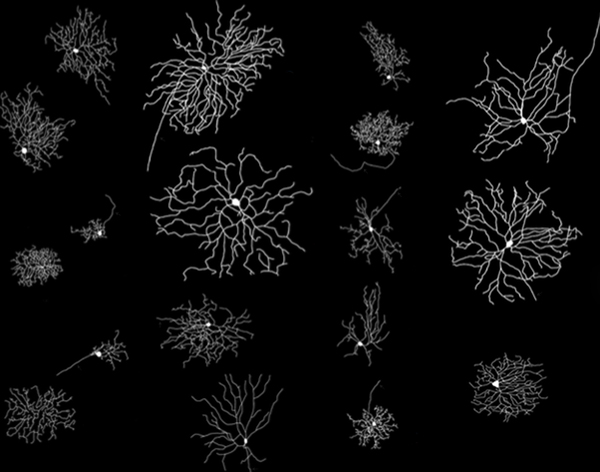This paper in the Journal of Neurophysiology by Raymond C S Wong, Shaun L Cloherty, Michael R Ibbotson and Brendan J O’Brien examined properties of retinal ganglion cells types that are conserved through mammalian species by looking at 16 morphologically defined rat and cat retinal ganglion cell types. Their work demonstrates morphologically distinct retinal ganglion cell types in rat that have homologs in cat retinal ganglion cells, but more importantly also have other intrinsic physiological features that both correlate function and also suggest variations that reflect the species individual environmental and behavioral demands.
Abstract:
Mammalian retina contains 15-20 different retinal ganglion cell (RGC) types, each of which is responsible for encoding different aspects of the visual scene. The encoding is defined by a combination of RGC synaptic inputs, the neurotransmitter systems used, and their intrinsic physiological properties. Each cell’s intrinsic properties are defined by its morphology and membrane characteristics, including the complement and localization of the ion channels expressed. In this study, we examined the hypothesis that the intrinsic properties of individual RGC types are conserved among mammalian species. To do so, we measured the intrinsic properties of 16 morphologically defined rat RGC types and compared these data with cat RGC types. Our data demonstrate that in the rat different morphologically defined RGC types have distinct patterns of intrinsic properties. Variation in these properties across cell types was comparable to that found for cat RGC types. When presumed morphological homologs in rat and cat retinawere compared directly, some RGC types had very similar properties. The rat A2 cell exhibited patterns of intrinsic properties nearly identical to the cat alpha cell. In contrast, rat D2 cells (ON-OFF directionally selective) had a very different pattern of intrinsic properties than the cat iota cell. Our data suggest that the intrinsic properties of RGCs with similar morphology and suspected visual function may be subject to variation due to the behavioral needs of the species.
Image Modified from Figure 1 of this manuscript.
